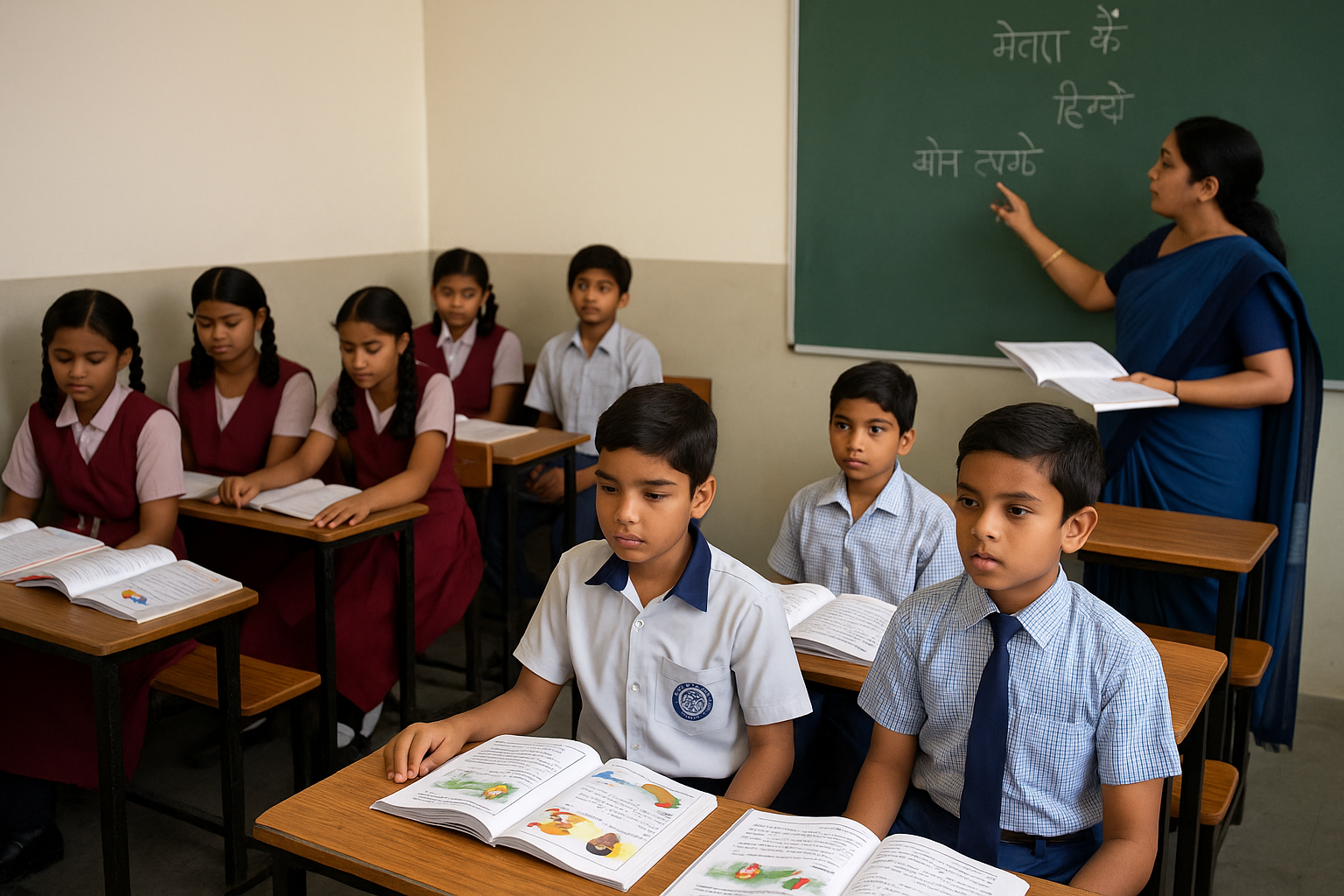In response to the Central Board of Secondary Education (CBSE) directive promoting education in the mother tongue or regional language, several English-medium schools in Delhi are beginning to integrate Hindi and other Indian languages into early-grade teaching. The move, aligned with the National Curriculum Framework (NCF 2023) and National Education Policy (NEP 2020), aims to make learning more accessible for children in their formative years.
CBSE’s New Policy on Language in Early Education
Under CBSE’s latest guidelines, schools across India have been instructed to prioritize the child’s home language or mother tongue as the medium of instruction up to Class 2. The shift follows the NCF 2023 recommendation that children learn foundational concepts in the language they best understand.
The board has asked affiliated schools to:
- Map students’ home languages before finalizing class sections.
- Use bilingual teaching methods (English + local language) wherever needed.
- Gradually align their curricula, materials, and teacher training to the multilingual model.
CBSE officials have clarified that the intent is not to eliminate English but to ensure conceptual clarity and emotional connection in the early learning years.
How Delhi’s Schools Are Responding
Several private and government schools in Delhi have already begun implementing bilingual classrooms and dual-language materials in pre-primary and early primary grades.
- Elite English-medium schools in areas such as South Delhi and Dwarka are experimenting with Hindi-led classroom interactions during storytelling, art, and moral science periods.
- Government-run schools, meanwhile, are expected to have a smoother transition, since many already use Hindi as the primary medium.
Education officials say the implementation will begin in full swing from the 2025–26 academic session, though teacher training and curriculum adjustments are still underway.
Why the Mother Tongue Push Matters
According to CBSE and education researchers, children learn faster, retain better, and express themselves more confidently when taught in their mother tongue.
Studies show that:
- Early exposure to a familiar language improves literacy and comprehension skills.
- It reduces dropout rates and increases classroom participation, especially among first-generation learners.
- Multilingual foundations help students learn English and other languages more efficiently later on.
“Children think and reason best in the language they grow up speaking. Introducing core concepts in that language gives them a lifelong academic advantage,” said a Delhi-based education consultant affiliated with the NCF implementation group.
The Challenge for Metro Schools
While the policy has a strong pedagogical basis, its execution in metropolitan areas like Delhi comes with unique challenges.
- Diverse student backgrounds – Delhi classrooms often include children speaking Hindi, Punjabi, Bengali, Tamil, Malayalam, Nepali, and Urdu.
- Teacher preparedness – English-medium schools will need teachers who can teach bilingually or switch languages effectively.
- Curriculum and materials – Many private schools rely on English-language textbooks that may not align with the new approach.
- Parent expectations – Urban parents often associate English-medium education with career success and global exposure.
School principals interviewed by The Hindu and Indian Express said they are open to incorporating Hindi instruction, but full adoption across multilingual classrooms will require flexibility from the board and additional resource support.
Government Schools May Lead the Way
The Delhi government, which manages over 1,000 schools, has said it supports the CBSE’s multilingual model and will help train teachers accordingly.
Officials from the Directorate of Education (DoE) noted that most Delhi government schools already teach in Hindi, with English offered as a parallel medium.
However, to balance parental demand, the government has also begun adding English-medium sections across grades — a dual approach intended to meet both policy objectives and public aspirations.
Balancing Language and Opportunity
The transition to mother-tongue instruction is part of a larger rethinking of India’s education model — one that seeks to preserve linguistic identity without compromising global competitiveness.
Experts argue that bilingual education — rather than pure Hindi- or English-medium systems — may offer the best of both worlds.
“Language shouldn’t be seen as a hierarchy,” said a senior Delhi educator. “The goal is to help children learn, not limit them. Teaching in both mother tongue and English can bridge understanding and opportunity.”
The Road Ahead
CBSE’s circular has set a 2025–26 target for full implementation, but the rollout will likely vary across schools.
Training modules for teachers, new textbooks under NCERT’s multilingual framework, and clear operational guidelines will shape how smoothly the policy works in cities like Delhi.
For now, schools are experimenting — some through dual-language modules, others through activity-based Hindi sessions. The coming year will test how India’s urban classrooms adapt to a system that puts language at the heart of learning once again.
FAQs
What is CBSE’s new mother tongue policy for schools?
The Central Board of Secondary Education (CBSE) has directed all affiliated schools to use the mother tongue or home language as the medium of instruction up to Class 2. The policy is based on the National Curriculum Framework (NCF 2023) and NEP 2020, which emphasize learning in a language children understand best.
When will the CBSE mother tongue policy take effect?
The implementation begins in the 2025–26 academic session, with schools expected to gradually introduce mother tongue-based instruction in pre-primary and lower primary grades.
Why is CBSE promoting education in the mother tongue?
Studies show that children learn faster and understand concepts better when taught in their home language. The policy aims to improve comprehension, confidence, and foundational learning outcomes during the early years of education.
How are Delhi’s English-medium schools responding to the policy?
Several private and government schools in Delhi are beginning to introduce Hindi and regional languages in early classes through bilingual teaching models — combining English with the child’s first language to make lessons more accessible.
Will English be removed from Delhi schools?
No. CBSE has clarified that English will continue to be taught and used as a secondary medium. The policy promotes multilingual education, not the replacement of English.
What challenges do Delhi schools face in implementing this policy?
Urban schools face hurdles such as linguistic diversity among students, shortage of bilingual teachers, and limited teaching materials in regional languages. Many parents also prefer English-medium instruction for career-related reasons.
Are government schools in Delhi also following this directive?
Yes. Most Delhi government schools already use Hindi as the main medium and are better placed to comply. However, they are also adding English-medium sections to balance policy goals with parental demand.
How will this change impact students?
Experts say learning in a familiar language will improve reading comprehension, classroom participation, and retention rates, especially for young learners. It may also strengthen cultural connection and cognitive flexibility.
What training or support is CBSE offering schools?
CBSE and NCERT are preparing teacher training programs and bilingual learning materials to help schools transition smoothly to mother tongue-based instruction without disrupting overall academic standards.
Will the new policy apply to all CBSE schools nationwide?
Yes. The directive covers all CBSE-affiliated schools across India, but implementation will depend on each school’s regional context, student demographics, and available language resources.

